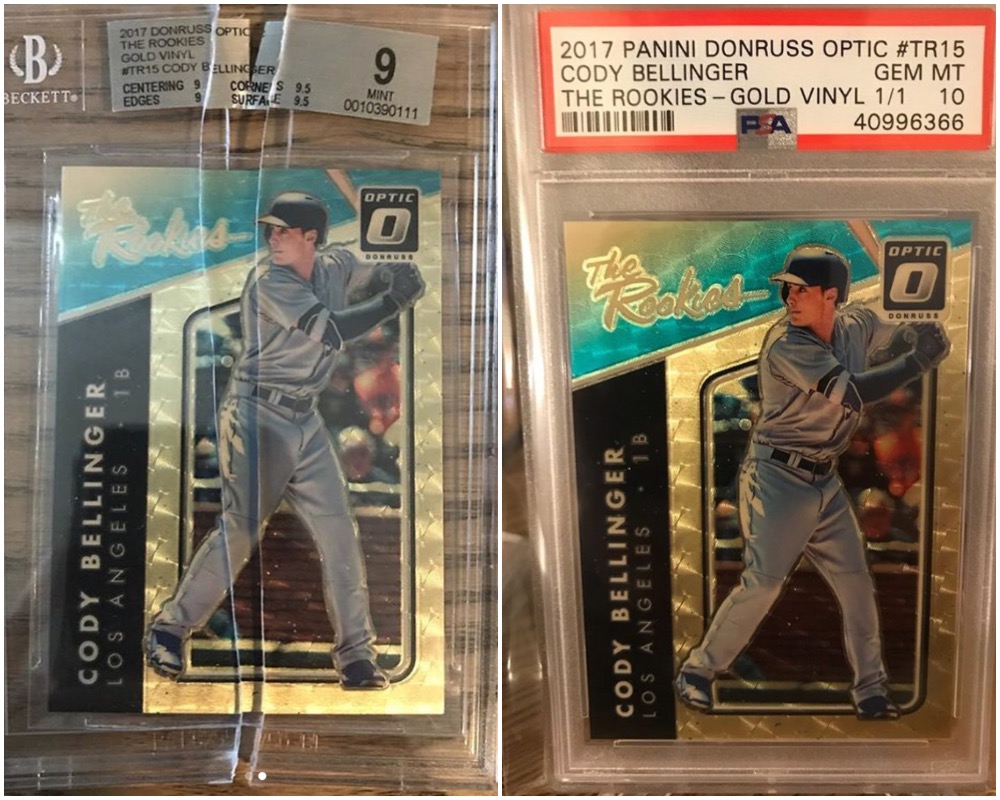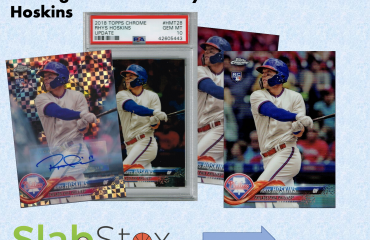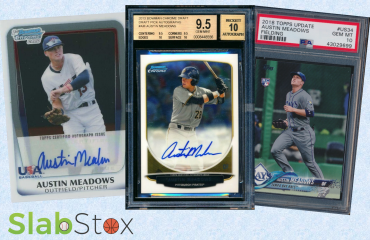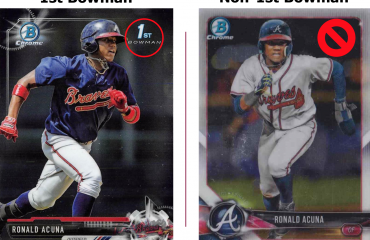The Curious Case of Population Reports

I’ve been around the hobby for quite some time, but two years ago is when I took it to the next level. Through the first year, I knew cracking graded cards and regrading to BGS or PSA (most likely) was a practice, but in the last year it has taken off. For those not in tune, cracking a graded card means breaking it out of its case to get it back into ungraded form.
If someone chooses, they can crack the card out to avoid grader bias, compared to if it was still in the case sent for a review.
Let me preface this article by making it clear I one-hundred percent support grading cards, buying graded cards, cracking your graded cards, or doing whatever you’d like with your cards and grading (unless it involves trimming or altering cards). You know, there is a reason I named it SlabStox.
This article should be viewed as purely educational.
Here is a quick example of how a crack and resubmit works:
You submit a Luis Robert Bowman’s Best Atomic Auto /25 to BGS and it comes back a BGS 9 with 9 centering, 9 edges, 9.5 corners, and 9.5 surface. Because grading is so subjective, you want to resubmit it to try to grab .5 higher on edges and come out with a BGS 9.5. Instead, it comes back not as a 9.5, but a BGS 10 PRISTINE, with 9.5 centering, 10 edges, 10 corners, and 10 surface.
That is not a hypothetical example; that happened to one of our writers, @psasportscards. His Robert got bumped up not .5 sub-grades, but a whole 2.5 sub-grades to get to the BGS 10 (congrats to him, for sure).
Not only does that affect the population report, as the same card has two different serial numbers in the system, but it taints it by there being such a discrepancy in one card.
I have nothing against people cracking and resubbing, I have done it myself for cross-overs to PSA. What I do have a problem with is the grading companies lacking consistency (not only with grading, but the turnaround times as well), and I think a lot of us would agree it is a major problem. Looking at the Robert, I think it is safe to say one of the two graders should not be grading our cards. Considering the 20 to $25+ fee per card at Beckett and PSA (for guaranteed orders), I want to make sure my card is getting graded fairly with better consistency.
Here is an example of a BGS to PSA crossover, thanks to @psasportscards again.

This Bellinger wasn’t a true gem (9.5s on all sub-grades), but still crossed to a PSA 10. It is popular belief (yet sometimes wrong) BGS 9.5s can only cross to PSA 10s if it has true gem sub-grades. One of the companies either under-graded or over-graded it.
Either these companies decided to have collectors resubmit their cards to generate more revenue, or they are truly inconsistent in their practice.
One day, I am sure we will see electronic grading where a program can process grades with 30x zooms, etc. The source of this information evades me, but I remember hearing there is a pending patent for a grading software.
Moving on from subjectivity of grading, let’s look at examples of big cards and their population reports.
2016 Bowman Chrome Juan Soto Orange Refractor Auto /25
BGS Pop Report: 32
10: 0
9.5: 14
9: 12
8.5: 3
8: 2
7.5: 1
PSA Pop Report: 4
10: 2
9: 2
Total Graded Population: 36
Total Orange Refractor Autos: 25
There are eleven more pop report Soto BC Oranges than there are in existence, and that is assuming every Soto Orange was graded (the probability of that is high, due to the value of the card).
What are the odds that the BGS 7.5, 8, or 8.5 are in the original slabs right now? My guess would be there is one 8.5 left, and that is it.
My next question would be, of the fourteen 9.5s, how many were originally graded 9.5?
Of course, this cannot be determined unless I were to document every single Soto Orange sale, the serial numbering, and what it was first graded. At this point, it is impossible to figure all of that out.
2016 Bowman Chrome Juan Soto Red Shimmer Refractor Auto /10
BGS Pop Report: 14
10: 0
9.5: 7
9: 6
8.5: 1
PSA Pop Report: 1
10:
9: 1
Total Graded Population: 15
Total Red Shimmer Refractor Autos: 10
2016 Bowman Chrome Vladimir Guerrero Jr. Orange Refractor Auto /25
BGS Pop Report: 31
10: 0
9.5: 16
9: 15
PSA Pop Report: 6
10: 4
9: 2
Total Graded Population: 37
Total Orange Refractor Autos: 25
2016 Bowman Chrome Vladimir Guerrero Jr. Blue Refractor Auto /150
BGS Pop Report: 134
10: 6
9.5: 87
9: 29
8.5: 10
8: 1
PSA Pop Report: 15
10: 7
9: 6
8: 1
5: 1
Total Graded Population: 149
Total Blue Refractor Autos: 150
For Vlad Jr. Blues the graded population doesn’t cover the total production, but it is only off by one. After looking at three cards /25 or lower, mixing in a card /150 makes sense to see if it spans to larger print runs. It is incredible to think a card with 150 produced in 2016 has 99% in pop reports.
Wrap-up
I wish there was a way for me to go back and track the sales of these cards with serial numbers to see which got bumped and which didn’t. It would be more useful research, but for now this will have to do.
Now that I think about it, I will attempt to track 2019 Bowman Chrome Wander Franco Orange Refractor autos and see where they end up being graded and resubmitted (this will be easy, I will own all of them).
If nothing else, this shows the subjectivity and money being funneled through the graded card business. This was only four examples of two different players from 2016. I looked into Mike Trout as well, and he has 163 total graded Blue Refractor autos out of 150 produced.
I am not trying to say graded cards shouldn’t be worth the hefty premium put on them; it is the best way to guarantee card protection (to a certain extent) and get a certified opinion on a card. For the fees the companies are charging and the timeframe it takes to get them graded, the graded card multiplier is definitely warranted, but their service needs to improve.
What are your thoughts on the production of a card versus graded population?
Previously on SlabStox: Prospect Profile: Oneal Cruz
Next on SlabStox: Prospect Profile: Nate Pearson
Sign up for The Daily Slab email to get the most up-to-date sports card insights straight to your inbox.



